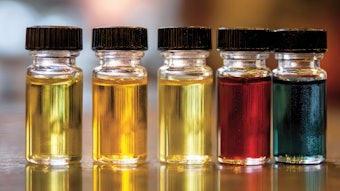The present article is part two in a series of two that provides the findings of various researchers on the chemical constituents in basil oil. Part 1 appeared in the May 2014 edition.
For examples, Dob et al. (2006) analyzed an oil produced from basil plants cultivated in Algeria. The complete listing of the components found is provided herein, in addition to trace amounts (< 0.05%) of α-pinene, camphene, (E)-β-ocimene, trans-verbenol, borneol, terpinen-4-ol, nerol, geraniol, linalyl acetate, bornyl acetate, neryl acetate, β-bourbonene, β-cubebene, β-caryophyllene, α-humulene, (E)-nerolidol, spathulenol, α-muurolol, β-eudesmol, α-bisabolol, (Z,E)-farnesol, methyl hexadecanoate, isophytol, phytol and eicosane in the same oil. The authors also mistakenly characterized exo-norbornyl acetate in this oil in error.
Also, seeds of 18 selections of O. basilicum were collected from local farms and home gardens in Turkey by Telci et al. (2006). These seeds were raised into plants at the Gaziosmanpas, a University Experimental Research Station (Tokat, Turkey). Once mature, plants from each of their origins were harvested in full bloom, and 20 g of each were separately hydrodistilled for 2 hr to yield oils ranging from 0.4–1.5%. The oils were analyzed by GC-FID and GC/MS to reveal a range in compositions. A summary of these compositional results also are detailed here, along with several others.










